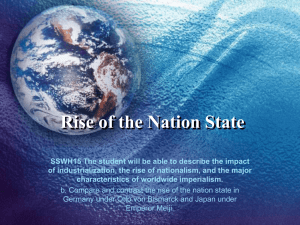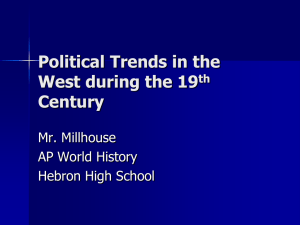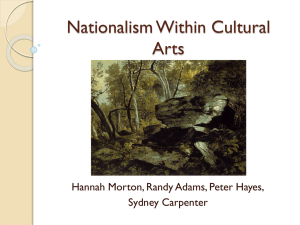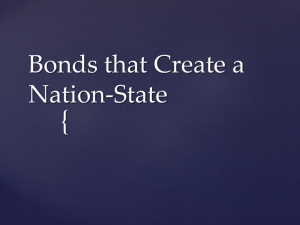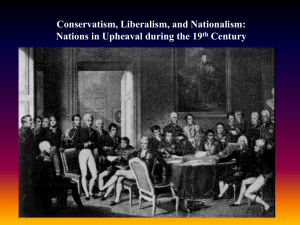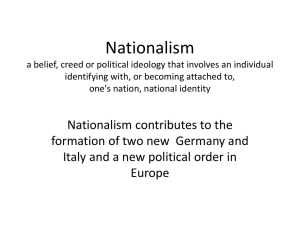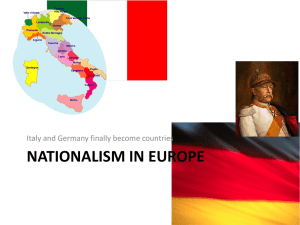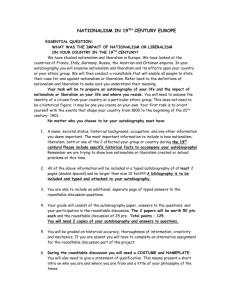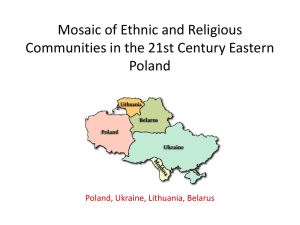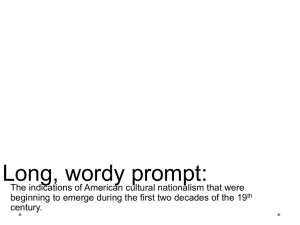Industrialization & Nationalism 1800-1870
advertisement
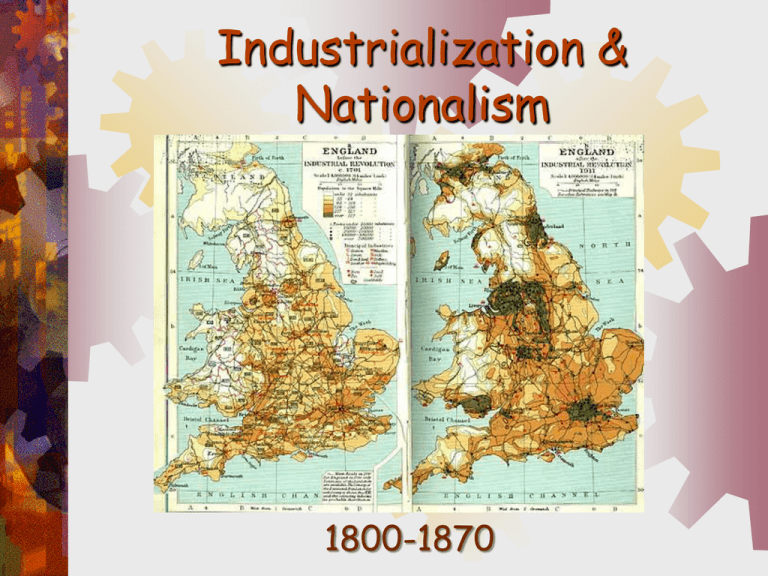
Industrialization & Nationalism 1800-1870 Factors of Production People James Watts Proletariat Stevenson Bourgeoisie Eli Whitney Class struggle Henry Ford Marxism Karl Marx Great Famine Essential Questions Trace patterns of industrialism in the world. Analyze how new innovations made industrialism more successful. Contrast the circumstances of labor [workers] before and after the Industrial Revolution. Discuss the emergence of industrial capitalism and its implications. Discuss the impact of industrialism on society. Cottage Industry / Factory System Cottage Industry Piecework directly tied to how much produced. Factory System Earnings Centralized work place> outside home Paid by how much time you worked Women & children paid less $ than men Machines set pace Made in home Direct control of workforce Family enterprise Limited breaks to Whole families maximize production helped Cottage Industry Factory System Patterns of Industrialization Great Britain First emerged there Favorable conditions & demand for textiles Mechanization Kay of Industry [1733]> flying shuttle increased production 100 X previous production Crompton’s mule [1779]> new spinning machine Cartwright’s [1785]> power loom Industrial Innovation Britain source of many innovations James Watt’s [1765]> steam engine Iron & Steel Use of coke to fuel furnaces Bessemer Process > cheap steel making Transportation Railroads & steam ships lowered costs Stevenson [1815] Steam powered locomotive New Social Classes Emerge Owner class Wealthy entrepreneurs & investors Well educated High standard of living Working Labor class force of poor / immigrants No education b/c child labor Exploited for their labor Industrial Capitalism Eli Whitney Machine tools Standardized interchangeable parts Henry Ford Assembly line production of automobile Lowered costs Paid workers more [$5 a day] Workers could afford cars [$200] Industrial Capitalism Big Businesses / corporations Were promoted b/c High cost of factories Capital investment British Laid & French legal groundwork for modern corporations Industrial Capitalism MONOPOLIES Direct domination of any industry CAPITALISTS Either formed: Trusts Many businesses run as one Cartels Groups that set production & price O.P.E.C. Spread of Industrialism Napoleonic Wars abolished guilds & trade barriers Facilitated W. Europe Belgium, industrialization in Germany, & France Industrialized by 1900 Social Impact of Industrialism Population growth Better diets & improved sanitation Urbanization Internal migration rural to urban Demographic Relative transition stability Voluntary birth control low fertility rate Urbanization & Migration Urbanization Internal migration From TRANSCONTINENTAL External migration Mostly Europe to America farms to 50M from early factories Growth in number & size of cities 19th to early 20th Cent. Social Impact of Industrialization New Social Classes Captains extreme wealth Middle class largest beneficiary Working of Industry class poorly paid, unskilled Social Implications INDUSTRIAL FAMILIES: Families lead separate lives Men gain stature Workers resisted work discipline Working women [only lower class] Child labor common because of low wages to family & child Casualties: 148 http://www.ilr.cornell.edu/trianglefire/ Great Famine Ireland A direct colony of Britain Oppressed among Western nations Dispossessed of their land and vote Tenants Potatoes Crop in their own land failure lead to famine Britain exported food during the famine 1M died / 2M emigrate Resistance to Industrial Domination KARL MARX Intense competition lead to exploitation Political & social institutions served only the interests of the capitalists Promoted “class struggle” Bourgeoisie Did vs. Proletariat Business owners / workers not believe capitalism could reform itself Nationalism Part 2 Essential Questions What influence did the Crimean War have on European nationalism? How did the Principles of Legitimacy and of Intervention impact European relationships? Compare the unification of Italy and the unification of Germany. Identify the reform movements of the era. People & Concepts Nationalism Congress of Vienna Crimean War Principle of Florence Nightingale Intervention Metternich Principle of Legitimacy Otto Von Bismarck Emancipation of Cavour & Girabaldi Serfs Czar Alexander II Ausgleich British North Documents of America Act Liberalism Queen Victoria Realpolitik Nationalism Nationalism IDEOLOGY OF A NATION STATE Emerged after the French Revolution Revolutions in Central Europe Based on universal male suffrage Austrian Empire Multinational state Fragmentation of interests of its people Impact of Crimean War CRIMEAN WAR Direct impetus for new alliances in Europe Russia & Austria now enemies Promoted a new rise of nationalism in the Balkans Spread throughout Europe Crimean War 1853-1856 Crimean War Florence Nightingale Congress of Vienna PEACE SETTLEMENT AFTER NAPOLEONIC WARS Metternich [Austrian foreign minister] Conservative ideologist PRINCIPLE OF LEGITIMACY PRINCIPLE OF INTERVENTION Great Powers Right to send armies to intervene with revolutions Opposition to Conservatism Liberalism Powerful & nationalism forces for change Liberalism Enlightenment was the source Supported Civil liberties, free speech, press, religion Separation of church & state Were not democrats Only equality and power to white men of property Documents of Liberalism American Declaration of Independence Equality Popular Sovereignty Life – liberty – pursuit of happiness Declaration of the Rights of Man and the Citizen Liberty– equality - fraternity Map Austria-Hungarian Empire National Unification Movements ITALY [1860] Mazzini’s Young Italy spurred uprisings Cavour Expelled Austria from northern Italy Garibaldi Consolidated south Vittore Emmanuele GERMANY [1871] Otto Von Bismarck Prime Minister Provoked wars to swell German pride Prussian Self-proclaimed Emperor Reich of 2nd Giuseppe Garibaldi Unification of Germany Bismarck Unified by force Autocratic rule Militarism Power base Realpolitik Practical ideology politics not based in Franco-Prussian War [1870] Reforms France King Louis Napoleon Created Napoleon III empire (r.1852-1870 Very successful until war with Prussia France returned to republic Reform Austria Ausgleich 1867 Split into two: Austria-Hungarian Empire Emperor Francis Joseph (r. 1848-1916) Reform Russia Czar Alexander II Emancipation of serfs Opposition of conservatives & demands of liberals forced his return to repressive rule Reforms Reforms Changes brought about indirectly by revolutions Britain Liberal parliamentary reform Queen Victoria’s sense of respectability Promoted stability economic & political Canadian Nation United Provinces of Canada United British upper & lower Canada North American Act Parliamentary move –feared American intentions Dominion of Canada Domestic self rule No control over foreign affairs Reform in the U.S. Divisive factor in U.S. Industrial south north / agricultural Lincoln – dedicated to free territories Southern economy base – slavery Democratic politics brought many into the fray Abolition – source of division Enduring Questions What are the long and short-term benefits of industrialism globally? What are the long and short-term problems that have emerged locally and globally as a result of industrialism? What past and present problems in the world can be traced to nationalism?
